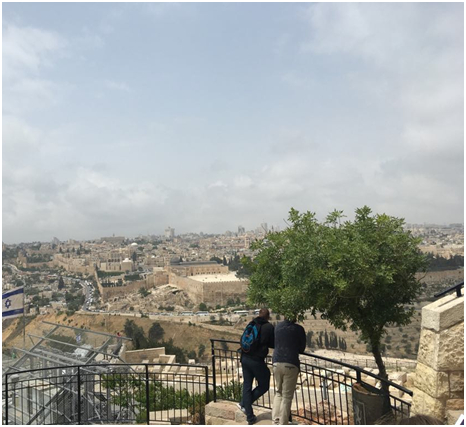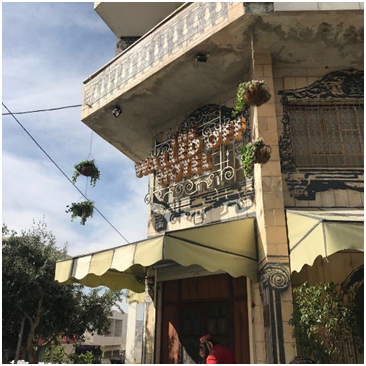Peering out of the minibus windows at the blocks of flats and small low shacks, taking a break from the bumpy roads to see the rooftop viewpoint. The dramatic moment along the road to Hebron, being told this used to be the busy shopping street, but it’s not anymore because… wait for it….rounding the corner to see the ugly concrete Separation Wall. Stopping to get out and take pictures, and getting back in the bus.

Tourists view the Old City of Jerusalem and the Silwan neighbourhood from afar Photo: Leah Tillmann-Morris
This is an experience among more and more visitors to Jerusalem; tourists taken into Palestinian areas, for the ‘other side of the story’. Every week, there are tour groups being taken into East Jerusalem and the West Bank by organisations such as Ir David, Green Olive Tours, Birthleft, Ir Amim, Alternative Tours, Experience Palestine and the list goes on. Now reaping the benefits of so-called ‘peace’ the tourism industry has grown.
This tourism of suffering seems misplaced. Groups of white westerners, including groups of Jews, are pushing their way into Palestinian villages and neighbourhoods, to ogle at the local community’s poverty, and be told stories about planning permission, unemployment and overcrowded classrooms. As if the military occupation was not enough, a spectator occupation is carried out as well. Often, groups are accompanied by soldiers for security, driving home their political allegiance to those to whom it may have been unclear. A Breaking the Silence testimonial describes Jewish tours of the Casbah (in Hebron) as a situation which is ‘really almost zoo-like in a sense. You enter to take a tour and look around and then you leave. -‘To look at a place in which people live in unbearable conditions.’ It becomes the pinnacle of entitlement, to demand a ready welcome and observation point into people’s lives as they do of the historical artefacts of their own identity.
There is, however, an important distinction to be made between the different kinds of visitors. Zionist tour groups, often led by local settlers as described in the Breaking the Silence testimonial, obviously have very different motivations to the groups of internationals (Jews and non-Jews) who come to observe, experience or become involved in activism and protests.
‘Occupation tourism’ also takes the form of what one might call ‘activist tourism’, exemplified by the phase of tourists regularly coming to the Bil’in village to watch Palestinian and Israeli protesters come into conflict with, be arrested by or subjected to tear gas by the Israeli army. Keen to see ‘the action’ for themselves, the conflict, protest and danger, rather than deterring tourists, attracted them to visit.
It is among this latter group, that questions about legitimacy, exploitation, raising awareness or genuine solidarity have any point in being asked. At worst, one might worry this tourism is exploitation -and it might even be a force to perpetuate unsatisfactory conditions, just to be sensational. People are paying money into it, and making money out of it. Interests develop towards putting on a show for the people who come to spend their money on the quality, authenticity, and intensity of the struggle.
A phenomenon of 21st century tourism?
Belhassen, Uriely and Assor of Ben Gurion University released a study in 2014, which recognised that tourists to certain regions of the West Bank are not visiting despite the unrest, but because of it. They identify that visitors to regions who have a ‘cosmopolitan’ outlook may be motivated to express that outlook or deepen their understanding of events and politics they access at home. Of ‘the Bil’in Experience’, in particular, they highlight the key conditions of ‘adventure’, ‘authenticity’ and also the ‘relatively controlled nature of the struggle’ necessary for tourist participation.
This phenomenon is not confined to Palestine; the travel destinations of the tour company WarZone Tours, (“the ultimate in adventure travel”) include Sudan and the Democratic Republic of Congo—“fascinating” regions of “wildlife, oil and AK-47s” according to its website. The Troubles of Northern Ireland, with which many parallels can be drawn, has also been attracting its fair share of ‘conflict tourism’. Chris Jenkins, writing for the Guardian, describes his unease that ‘Tourists take photos of the division lines that are not consigned to history, but are a part of living Belfast: children play football against the walls that tourists flock to. The places and the people themselves have become a spectacle, an attraction.’ To see a weapon or tool of past suffering is to see an artefact; but present suffering can never be impartial or in isolation to the people it affects. There are naturally fewer moral qualms about visiting tourist sites of Tiananmen Square or the Berlin Wall, although the Bethlehem Wall might feel similar. They are both tall, concrete slabs lining up next to each other to snake into the wire-topped wall, adorned with graffiti. They both cut up and silence functioning cities.
Yet what makes tourism of the Berlin Wall so different to the Bethlehem wall is basic: the fact that it is still active, still in use, still a very real part of everyday life for communities and not just a relic of the past to be consigned to history books.
Fame, beauty and normalisation
The beautification and fame brought to the Bethlehem wall through graffiti has not been universally welcomed. Many people oppose the way in which the graffiti and modern art painted onto the Bethlehem wall trivialises and fictionalises the occupation. The ‘Walled Off Hotel’, financed and partly designed by Banksy, the British graffiti artist... boasts ‘the worst view in the world’ (i.e. the Separation Wall), successfully attracts visitors to the West Bank. More tourists means more business- and that can’t be a bad thing for Bethlehem (restaurants, shops, a juice stand from Dheisha refugee camp, demand for taxis etc have all shot up as a result of this westerner-centric attraction). Yes, the hotel is the definition of gimmicky - but art draws people in who might otherwise have gone unaware. A friend of mine describes meeting a clueless someone there to see the Banksy, who was just then getting around to asking ‘so I heard there’s some conflict between Israel and Palestine - why has the border got this wall?’
Potentially, the fact that the oppression is not yet history makes it even more important for outsiders to see. Though the idea of taking selfies by it makes me thoroughly uncomfortable, I can’t deny that the bright graffiti creates ‘good photo ops’ for social media – a valuable campaign medium. Even Banksy’s Walled Off is more of a museum with some bedrooms, whose profits go to the city of Bethlehem (not Banksy), than a business, and is officially owned by a Palestinian man; to be very knowledgeable about the situation and still have purely mercenary interests seems unlikely. Touring organisations are also not purely doing it for the money.

The Walled Off Hotel, Bethlehem Photo: Ryan Wentz
Rather, all these people are doing it to educate others, and while it may be true that ‘experiential learning’ is a luxury of the rich who can afford to travel, it is their influence that is sought anyway.
Inspiration and Incitation
One can’t really go away less informed; but whether it has the right emphasis, conveying the sense of urgency and suffering created by the occupation is another question. Firstly, the line between ‘engaging’ and merely ‘crass’ is thin. Secondly, the education visitors receive on these tours is undoubtedly biased and strong political propaganda. LA Gang Tours:, which also makes places of violence and suffering into tourist attractions, has ‘two extremes we always need to avoid. One is demonizing the gang member, and the other extreme is romanticizing the gang.’ If this is challenging, to give a political tour of areas of Palestine is a hundred times more contentious. Visitors with varying levels of prior knowledge, varying positions on the political spectrum will react with belief and disbelief, be open or become defensive, and with plans to help fight the occupation, or not do much about it at all. The Economist concluded that when done sympathetically, such travel enhances our understanding of difficult situations. It’s pathetic that awareness is so low as to need this treatment, but it is certainly raised.
Thus, the question remaining is what those who visit do to respond to this. On a superficial level, tourists to the Walled Off Hotel get the chance, facilitated by the ‘wall mart’ next door, which sells stencils for graffiti art, to feel like they participated and are ‘part of’ the ‘conflict’. But is it necessary, not only to increase the outside world’s understanding of the situation but to motivate it to help alleviate the hardship? Do visitors to the West Bank have a duty to engage in the political struggle of the region? And are their hopeful tour guides guilty of ‘normalisation’ if it’s something they don’t do?
